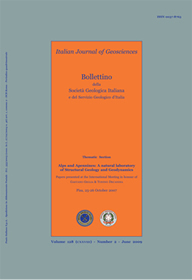
Evoluzione recente e rischio di erosione della costa molisana (Italia meridionale)
Pietro P.C. Aucelli(*), Emanuela Iannantuono(**), Carmen M. Rosskopf(**) & (***)
(*) Dipartimento di Scienze per l'Ambiente, Università degli
Studi di Napoli «Parthenope», Centro Direzionale, Isola C/4 - 80143 Napoli. E-mail: pietro.aucelli@uniparthenope.it.
(**) Dipartimento di Scienze e Tecnologie per l'Ambiente e il
Territorio, Università degli Studi del Molise, Contrada Fonte Lappone - 86090 Pesche. E-mail: emanuela.iannantuono@unimol.it, rosskopf@unimol.it.
(***) Corresponding author.
DOI: https://doi.org/10.3301/IJG.2009.128.3.759
Volume: 128 (2009) f.3
Pages: 759-771
Abstract
As documented by various recent studies (AUCELLI et alii, 2004; FAILLACE, 2004; IANNANTUONO et alii, 2005; Gruppo Nazionale per la Ricerca dell'Ambiente Costiero, 2006a; AUCELLI et alii, 2007; IANNANTUONO, 2007), the evolution of the 36 km long Molise coast during the last fifty years is characterised by a prevailing tendency to shoreline retreat.
The aim of the present paper is to provide a precise description of the Molise coast with reference to its coastal morphology along with a detailed frame of the evolution of its shoreline and first indications on the potential erosion risk.
The Molise coast that includes ca. 13 km of high coast behaves altogether as a low coast system, because the cliffs limiting the high coast to the sea are located, except for the promontory of Termoli, at variable distance from the shoreline. Beaches are present nearly all along the coast and anthropic structures frequently are located along their inner edges.
To analyse shoreline variations in detail, the Molise coast was subdivided in nine reaches (T1-T9) of different lengths and characters. Quantitative analyses on linear shoreline variations and related surface changes were carried out for the 1954-2003 time interval and relative sub-periods 1954-1992 and 1992-2003. From 1954 to 2003, the general shoreline retreat caused a total loss of ca. 1.090.000 m2 of coastal area (beaches, dunes, deltaic and retro-dune areas). The most sensible reaches to erosion are T1 and T7 that respectively comprise the mouths of the Trigno and Biferno rivers, which experienced in this period a retreat of ca. 250 and 350 metres, respectively. A consistent acceleration of shoreline retreat with time is shown by the comparison between sub-periods 1954-1992 and 1992-2003. Though the second period is much shorter (11 years vs. 38 years), T1 and T7, in particular, totalize nearly 50% of the surface losses that occurred during the precedent period. Due to such an acceleration, during the second period ca. 32% of the total erosion occurred, giving rise to a loss of ca. 348.609 m2. For reaches T1 and T7, the average annual retreat rates changed from respectively 2.37 and 3.24 m/y to 4.24 and 4.74 m/y during the second period, when reach T7 underwent a maximum retreat of about 231 metres which corresponds to an average annual retreat of 21 m/y.
The reconstructed acceleration of erosion is in net contrast to the increasing protection of the coast by defense structures as evident above all for reach T7. In order to better understand this apparent inconsistency, and the consequent hypothesis for a possible meteoclimatic influence (already outlined for part of the Molise coast by AUCELLI et alii, 2007), a detailed analysis of the period 1992-2003, subdivided therefore into sub-periods 1992-1997, 1997-2000, 2000-2003, was carried out. This analysis showed consistent differences between the distinguished sub-periods in relation to average annual shoreline variations and the percentage with which each reach contributed to erosion. The observed differences strongly support the hypothesis that variations of meteomarine conditions have strongly favoured erosion during the second period, and in particular during sub-period 2000-2003, thus outlining the need to adequately consider such climatic influence when developing potential erosion scenaries related to climate change.
Starting from the basic morphological and topographical features of the Molise coast, in order to examine the potential erosion risk, the rates of annual average linear shoreline variations for periods 1954-1992 and 1992-2003 were examined on the basis of the risk scheme developed by GORNITZ et alii (1994). Such an examination allowed to evaluate the degree of erosion risk for each reach and to attribute, in particular, a very high erosion risk to reaches T1 and T7, which, indeed, are the main responsible for the observed shoreline instability.
Further analyses carried out on coastal sectors characterised by the occurrence of constructions located up to ca. 200 m from the current shoreline along the inner edges of the beaches, allowed to calculate the potential time span required by marine erosion to possibly affect the constructions. Said calculations point out for the northern sectors of reaches T1 and T7 time spans of 13,5 and 22 years, respectively, and therefore a real, and very high erosion risk.
Keywords
Get Full Text